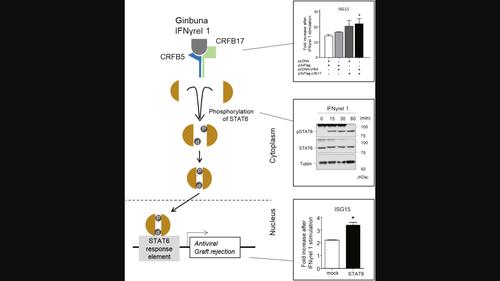当前位置:
X-MOL 学术
›
FEBS Open Bio
›
论文详情
Our official English website, www.x-mol.net, welcomes your feedback! (Note: you will need to create a separate account there.)
Characterization of fish-specific IFNγ-related binding with a unique receptor complex and signaling through a novel pathway
FEBS Open Bio ( IF 2.6 ) Pub Date : 2024-02-06 , DOI: 10.1002/2211-5463.13769 Yasuhiro Shibasaki 1 , Takeshi Yabu 1, 2 , Hajime Shiba 1 , Tadaaki Moritomo 1 , Nobuhiro Mano 1 , Teruyuki Nakanishi 1, 3
FEBS Open Bio ( IF 2.6 ) Pub Date : 2024-02-06 , DOI: 10.1002/2211-5463.13769 Yasuhiro Shibasaki 1 , Takeshi Yabu 1, 2 , Hajime Shiba 1 , Tadaaki Moritomo 1 , Nobuhiro Mano 1 , Teruyuki Nakanishi 1, 3
Affiliation

|
Unlike mammals, fish express two type II interferons, IFNγ and fish-specific IFNγ (IFNγ-related or IFNγrel). We previously reported the presence of two IFNγrel genes, IFNγrel 1 and IFNγrel 2, which exhibit potent antiviral activity in the Ginbuna crucian carp, Carassius auratus langsdorfii. We also found that IFNγrel 1 increased allograft rejection; however, the IFNγrel 1 receptor(s) and signaling pathways underlying this process have not yet been elucidated. In this study, we examined the unique signaling mechanism of IFNγrel 1 and its receptors. The phosphorylation and transcriptional activation of STAT6 in response to recombinant Ginbuna IFNγrel 1 (rgIFNγrel 1) was observed in Ginbuna-derived cells. Binding of rgIFNγrel 1 to Class II cytokine receptor family members (Crfbs), Crfb5 and Crfb17, which are also known as IFNAR1 and IFNGR1-1, respectively, was detected by flow cytometry. Expression of the IFNγrel 1-inducible antiviral gene, Isg15, was highest in Crfb5- and Crfb17-overexpressing GTS9 cells. Dimerization of Crfb5 and Crfb17 was detected by chemical crosslinking. The results indicate that IFNγrel 1 activates Stat6 through an interaction with unique pairs of receptors, Crfb5 and Crfb17. Indeed, this cascade is distinct from not only that of IFNγ but also that of known IFNs in other vertebrates. IFNs may be classified by their receptor and signal transduction pathways. Taken together, IFNγrel 1 may be classified as a novel type of IFN family member in vertebrates. Our findings provide important information on interferon gene evolution in bony fish.
中文翻译:

鱼类特异性 IFNγ 相关结合与独特受体复合物的表征以及通过新途径的信号传导
与哺乳动物不同,鱼类表达两种 II 型干扰素:IFNγ 和鱼类特异性 IFNγ(IFNγ 相关或 IFNγrel)。我们之前报道了两种 IFNγrel 基因 IFNγrel 1 和 IFNγrel 2 的存在,它们在银鲫鱼(Carassius auratus langsdorfii)中表现出有效的抗病毒活性。我们还发现 IFNγrel 1 会增加同种异体移植物的排斥反应;然而,该过程中的 IFNγrel 1 受体和信号通路尚未阐明。在这项研究中,我们研究了 IFNγrel 1 及其受体的独特信号传导机制。在 Ginbuna 衍生细胞中观察到 STAT6 响应重组 Ginbuna IFNγrel 1 (rgIFNγrel 1) 的磷酸化和转录激活。通过流式细胞术检测 rgIFNγrel 1 与 II 类细胞因子受体家族成员 (Crfbs)、Crfb5 和 Crfb17(也分别称为 IFNAR1 和 IFNGR1-1)的结合。 IFNγrel 1 诱导型抗病毒基因 Isg15 在 Crfb5 和 Crfb17 过表达的 GTS9 细胞中表达最高。通过化学交联检测 Crfb5 和 Crfb17 的二聚化。结果表明,IFNγrel 1 通过与独特的受体对 Crfb5 和 Crfb17 相互作用来激活 Stat6。事实上,这种级联不仅不同于 IFNγ 的级联,也不同于其他脊椎动物中已知的 IFN 的级联。干扰素可根据其受体和信号转导途径进行分类。综上所述,IFNγrel 1可被归类为脊椎动物中新型的IFN家族成员。我们的研究结果提供了有关硬骨鱼干扰素基因进化的重要信息。
更新日期:2024-02-06
中文翻译:

鱼类特异性 IFNγ 相关结合与独特受体复合物的表征以及通过新途径的信号传导
与哺乳动物不同,鱼类表达两种 II 型干扰素:IFNγ 和鱼类特异性 IFNγ(IFNγ 相关或 IFNγrel)。我们之前报道了两种 IFNγrel 基因 IFNγrel 1 和 IFNγrel 2 的存在,它们在银鲫鱼(Carassius auratus langsdorfii)中表现出有效的抗病毒活性。我们还发现 IFNγrel 1 会增加同种异体移植物的排斥反应;然而,该过程中的 IFNγrel 1 受体和信号通路尚未阐明。在这项研究中,我们研究了 IFNγrel 1 及其受体的独特信号传导机制。在 Ginbuna 衍生细胞中观察到 STAT6 响应重组 Ginbuna IFNγrel 1 (rgIFNγrel 1) 的磷酸化和转录激活。通过流式细胞术检测 rgIFNγrel 1 与 II 类细胞因子受体家族成员 (Crfbs)、Crfb5 和 Crfb17(也分别称为 IFNAR1 和 IFNGR1-1)的结合。 IFNγrel 1 诱导型抗病毒基因 Isg15 在 Crfb5 和 Crfb17 过表达的 GTS9 细胞中表达最高。通过化学交联检测 Crfb5 和 Crfb17 的二聚化。结果表明,IFNγrel 1 通过与独特的受体对 Crfb5 和 Crfb17 相互作用来激活 Stat6。事实上,这种级联不仅不同于 IFNγ 的级联,也不同于其他脊椎动物中已知的 IFN 的级联。干扰素可根据其受体和信号转导途径进行分类。综上所述,IFNγrel 1可被归类为脊椎动物中新型的IFN家族成员。我们的研究结果提供了有关硬骨鱼干扰素基因进化的重要信息。



























 京公网安备 11010802027423号
京公网安备 11010802027423号